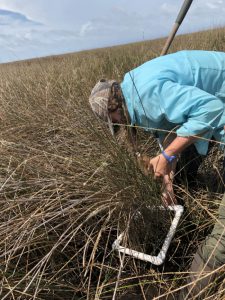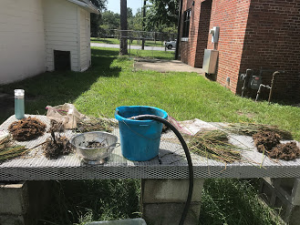Written by 2019 Summer Intern Sarah Tevlin, with hosts Carrie Adams and Stephanie Verhulst with UF IFAS Environmental Horticulture Department.
 A Study in Splinters.
A Study in Splinters.
This summer, I had the honor of working with the Carrie Adams Restoration and Plant Ecology Lab researching the effects of sea-level rise on salt marshes. Two to three times a week, I was able to boat or canoe along the Nature Coast, traveling via tidal creek into the salt marsh to collect samples from Black Needle Rush (Juncus Romarianus). Sounds amazing right? Between the boating, gorgeous views, and the opportunity to gain field experience, I couldn’t think of a better way to spend the summer. The only catch? Splinters. It turns out, Black Needle Rush is aptly named.
The Project

Specifically, the project hoped to determine if, and in what ways Black Needle Rush expressed stress as the salinity levels it was exposed to increased. To accomplish this, we visited 12 different tidal creeks along the Nature Coast. Along each creek, we had 3 different sites – one near the creek mouth, one at mid-creek, and a third near the top of the creek. At each site, we had two plots – one along the creek bank and another 40 meters inland. At each of our 72 total plots we collected above and below-ground biomass, soil cores, and samples to analyze the plant’s proline levels, lignin, and water content.

Getting Focused…
My focus was on biomass as an indicator of stress. I hoped to determine if the plant’s above and below-ground biomass varied with respect to distance to the coast and creek edge. For analysis at each site, I took above-ground biomass samples from a quarter square meter plot and below-ground biomass from a fourth of the same plot. Back in Gainesville, samples were thoroughly rinsed in order to remove any remaining sediment from the roots and stems. Once clean, the samples were dried and weighed.

The Splinters Were Worth It
I am incredibly grateful to NCBS and the Carrie Adams Restoration and Plant Ecology Lab for providing me with this opportunity. Having the opportunity to study one of Florida’s most iconic landscapes was an amazing experience. It turned out that, surprisingly, biomass levels didn’t predict marsh die-off. I loved working with everyone at the Carrie Adams Lab and the value of the field experience I gained this summer is immeasurable. I am so thankful for the chance to be an NCBS intern. It truly was a summer to remember.
 0
0
